Thai Amulet 2 Antiques Phra Ruang Buddha
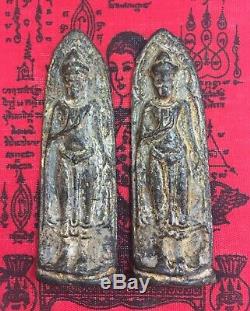
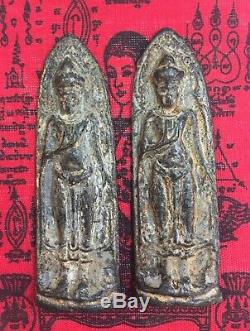
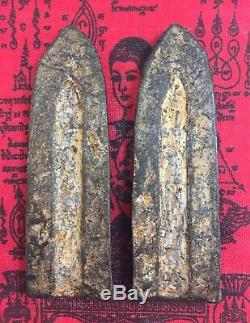
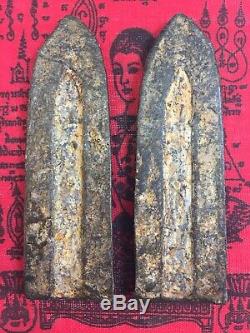
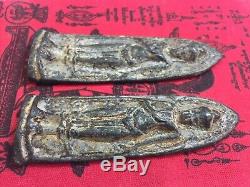
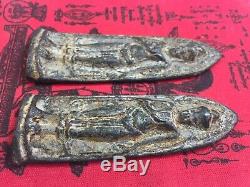
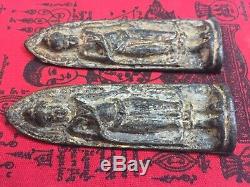
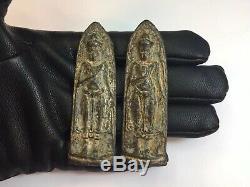
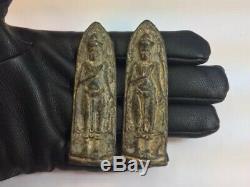
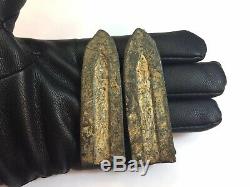
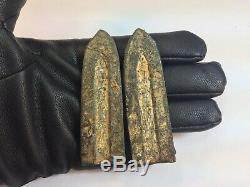
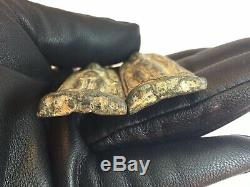

Thai Amulet 2 Antiques Buddha. The two Antiques Buddha was belong to an old Canadian amulets collector who died 2009, He did left lots of the amulets for his son, who do not know nothing about The amulets or Thai amulets. I do not know about this amulet either, where or which temple or which monk or who did made this amulet.
The amulets was made of (metal) lead. The size of the amulets approximate : 7.8cm X 2.4cm X 0.2-0.6cm.
Greeting from Canada to the world. Phra Ruang, the name of the dynasty of the monarchs that ruled the Sukhothai Kingdom and a name of hero in Thai legends, has evolved into a generic name for all ancient Sukhothai monarchs or rulers since 14th century. The word Ruang means prosperous or glorious. It is believed that Phra Ruang was a monarch who had accomplished a large amount of merit in his previous life, his words were sacred and wise, and with his great knowledge of arts and science, he managed to send out junks to trade with China, being married to the Emperors daughter and bringing back Chinese potters to produce ceramics in Sukhothai. In the circle of votive tablet collectors, the name Phra Ruang has been used to call two different groups of votive tablets. The first group depicts a standing Buddha image in the attitude of granting blessings. The well-known collections include, for example, the repository of Wat Phra Si Rattana Mahathat in Sukhothai, the repository of Maha Thera cave in Lop Buri and the repository of Nong Chaeng in Suphanburi. The Buddha image in this group shows a characteristic of the Khmer-influenced Bayon style.The second group depicts sitting Buddha image. The characteristics and iconographic details are variable.
Each is named according to the site it has been found. The Buddha style is characteristic of the Lop Buri and Sukhothai arts.
The sitting Buddha in the style of the Lop Buri art is usually depicted in royal attire and, sometimes, seated inside a flame-like aureola, displaying both the attitude of meditation and subduing Mara while the one in the Sukhothai style is usually found displaying the attitude of subduing Mara and is not highly ornamented. The Buddha characteristics are the same as the votive tablets of the Sukhothai art that have been generally found. It is assumed that the term Phra Ruang as given to the group of the standing Buddha image may derive from Phra Ruang Rojanarit, the standing Buddha image of the Sukhothai style that King Rama VI had it transferred from Si Satchanalai, restored and enshrined in the Vihan, north of the Phra Prathom Chedi in Nakhon Prathom.The reason is that the votive tablet collectors viewed that the Buddha style of both images shared similar characteristics. A Thai Buddha amulet (Thai:), often referred to academically as votive tablet, is a kind of Thai Buddhist blessed item. It is used to raise funds to help the temple producing the amulets. After the donation, the monk will give them amulet as a gift. With the change of time, the amulets no longer simply are considered a "gift" but a tool to help enhance luck in different aspects of life.
People use amulets to improve their marriage, wealth, health, love and relationships. It is also a Thai tradition to place amulets under a stupa or other temple structure when it is built. When the structure collapses, many amulets may be found. Some can be over a century old.
Almost every Thai Buddhist has at least one Thai amulet. It is common to see young or elderly people wear one or many amulets around the neck in order to get closer to the Buddha. Amulets are made using the Buddha image, image of famous monk, or even image of the monks who made the amulets themselves and let believers wear on for security and peace.
Amulets have different kind of sizes, different shapes and different materials such as plaster, bone, wood, metal. It may include ash from incenses or old temple structure, hair from famous monk, to add protection power to the amulets. After the amulets were made, the maker will then ask the monks who live in temples or monks from other temples join together and practice will, chant, pray and bless the amulets, this process may need at least one week more than three years.
When a new amulet is freshly made, its plaster appearance may not be attractive or gorgeous. By adding a protective casing the appearance of the amulet is enhanced and at the same time the amulet inside is protected. The price of an amulet not only depends on its appearance, but also on its scarcity, maker (which monk or magician), age and the magic classes as well.Famous markets for amulets include the Tha Phrachan market next to Thammasat University. However, many amulets at the Tha Prachan market are considered to be'fake', meaning replicas that have not been blessed by a monk. It is very unlikely indeed that you will find a real amulet in the Tha Prachan market. Many collectors and devotees have a trusted dealer of authentic amulets, for the study and authentication of real amulets is as complex a matter as is to be found in the antique trade, or in similar niches such as stamp collection.
Forgeries are rife, and it takes decades of study and experience to develop the skills needed to recognise authentic amulets. There are literally millions of editions from hundreds of thousands of temples, spanning centuries, and it is not possible for one person to encompass enough knowledge to be able to authenticate every single edition. Hence, each expert has his own chosen line of amulets, from a particular type, temple or Guru Master, which he chooses as his personal speciality and field of expertise. The most famous of Thai amulets are the set of 5 rarest and highly sought after amulets Phra Somdej Wat Rakhang (Thai:), Phra Rod(Thai:), Phra Nang Phaya (Thai:), Phra Phong Suphan (Thai:) and Phra Sum Kor (Thai:), together called Benja Phakhi (Thai:). They are valued at over 10 million Baht.This time is approximately, some delays are possible. Please be patient and wait, until Your item arrived. Each package came with a gift inside. THANK YOU FOR YOUR VISIT.
The item "Thai Amulet 2 Antiques Phra Ruang Buddha" is in sale since Wednesday, May 15, 2019. This item is in the category "Collectibles\Religion & Spirituality\Buddhism\Amulets & Pendants". The seller is "djclon3r" and is located in Montreal, Quebec. This item can be shipped worldwide.- Country/Region of Manufacture: Thailand

